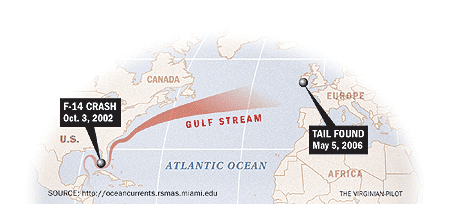
Posted on 05/10/2006 6:32:14 PM PDT by wagglebee
 |
| Jane Melia and Charlie Coughlan look at the tail section of an F-14 Tomcat from Oceana Naval Air Station that washed ashore at Long Strand near Owenahincha, Ireland, on May 5. DENIS MINIHANE PHOTOS / THE IRISH EXAMINER |
NORFOLK — A tail section from an F-14 Tomcat discovered on a beach in Ireland came from an Oceana-based plane that crashed 3½ years ago off Key West, Fla., the Navy confirmed Tuesday.
How it got at least 4,900 miles away, no one knows for certain.
As if it had been a corked bottle with a message inside, the find has created keen interest both in Ireland and the United States.
Speculation is that the nearly 10-foot-long triangular piece of vertical stabilizer – one of two on the jet – was floated by currents from the Gulf of Mexico near the tip of Florida to the beach in West Cork on Ireland’s southern shores.
A retired commercial airline captain, identified by the Irish Examiner as Charlie Coughlan, found the plane part Friday, according to the newspaper. He notified the Irish Aviation Authority.
Initially, it was feared that the tail fin had fallen off during a flight, until the Navy confirmed that markings on the section – including squadron insignia and a serial number – pointed to the jet that crashed off Florida on Oct. 3, 2002.
“Nobody has any idea how that vertical stabilizer got all the way up there,” Cmdr. Chris Sims, a spokesman for the Atlantic Fleet Naval Air Force in Norfolk, said Tuesday.
“It must have been floating in the water for three and a half years, or maybe something happened and the aircraft wreckage shifted and it broke off,” he said.
What is known is that an F-14 crashed when a compressor stalled in one of its engines. Both crew members safely ejected and were picked up by helicopter. They sustained minor injuries.
They had been with several other F-14s on a training mission and had been assigned to Fighter Squadron 101, a training squadron, at Oceana Naval Air Station in Virginia Beach.
The squadron has since disbanded.
The piece of wreckage, described as about the size of a family car, was in remarkably good shape. The paint was intact, along with the squadron’s insignia of a Grim Reaper.
The Navy is retiring its fleet of F-14s with just one squadron remaining in limited operations. That, too, will be disbanded this fall when the aviators transition to F/A-18s.
Coughlan said the metal tail looked new and contained no barnacles or corrosion.
“It is quite a substantial piece,” he told the Irish Examiner. “You would think it would have sunk, but the inside is layered with honeycomb material, and that could have made it buoyant.”
Although Navy officials initially said they wanted to recover the wreckage after the crash, they have not done so, Sims said. There are no plans to send an investigator to the place where the plane crashed or to Ireland to view the tail section.
“When an air crew ejects and is recovered uninjured, they can pretty much tell us what happened with the airplane, and there is not really a need to recover it,” he said.
The mystery of how the tail got a continent away remains, though.
“It probably went through the Strait of Florida and in the Gulf Stream, past Cape Hatteras and kept on floating,” said Larry Atkinson, an oceanographer and the Slover Professor at Old Dominion University in Norfolk. “It’s just amazing.”
Atkinson said he doubted last summer’s string of hurricanes in the Gulf of Mexico caught the piece and moved it around to the Atlantic Ocean side of Florida.
It could have been held up by rocks off the Irish coast and finally someone spotted it, he said.
Atkinson was reached for comment in Copenhagen, Denmark, where he was attending a conference with Irish and British colleagues on Tuesday.
“This will make for a great dinner discussion,” he said by telephone.
Reach Jack Dorsey at (757) 446-2284 or jack.dorsey@pilotonline.com.

What a moron! Look at your own article's map...how did it get there? It's called the Gulf Stream, dumbass
Ping
Someone's going to blame Ryanair for this....
I know with out any doubt how it got there. It rode the Gulf Stream. There is nothing remarkable or amazing about the journey.
A very large and indestructable object simlply floated in the current.
No kidding. This reporter sure ain't a master of the obvious.
The F-14's tail is made of a boron composite skin over an aluminum honeycomb structure. It's made to be very light and strong (in aircraft design, a high strength-to-weight ratio is a must). Floating in the ocean and catching a ride on the gulf stream is no big deal for this thing. It was bound to wash up somewhere.
Disclaimer: Opinions posted on Free Republic are those of the individual posters and do not necessarily represent the opinion of Free Republic or its management. All materials posted herein are protected by copyright law and the exemption for fair use of copyrighted works.